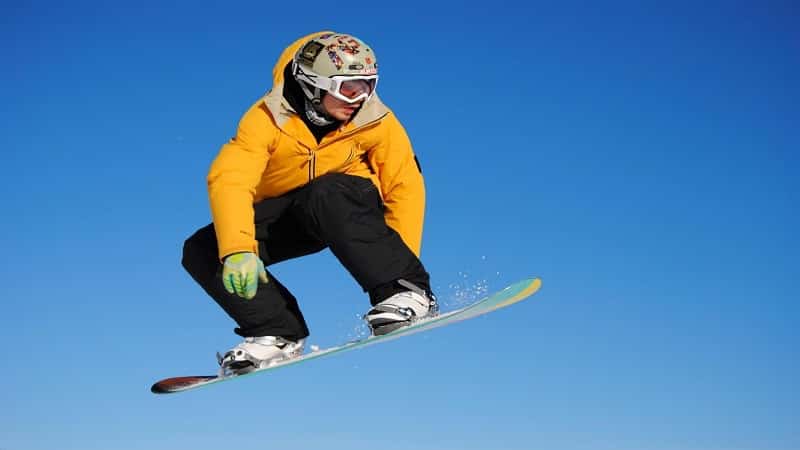The world of snowboarding has different riding styles and techniques, one of them including freeriding. Freeriding means when you’re free to ride the terrain your way as there are fewer to no people present while the terrain is also more extensive. Freeride snowboarding has become quite common among snowboarders. It allows you not to think so much about hurting anyone with your snowboarding. When fewer people are in the snow, you can practice your carves and turns a lot more freely.

What Is Freeride Snowboarding?
If you’re new to snowboarding, it’s all right if you’re unfamiliar with the concept. However, if you plan on becoming an avid snowboarder, it’s better to learn different riding styles and snowboarding terms to get more acquainted with the sport. Freeride snowboarding allows snowboarders to practice their skills more openly in the snow without worrying about the terrain.
The word “freeride” comes from the fact that a snowboarder is free to ride their snowboard according to their will. Mostly, the terrain isn’t as compliant, not to mention one has to think about other people in the snow. If you ride too fast in the snow, you might hurt someone if you lose control of your board. That doesn’t happen while freeriding as there’s almost nobody around.
So, if you’re looking to practice your snowboarding skills, look for a more significant terrain that allows you to freeride. It’s merely a riding style that some snowboarders consider their favorite. The more expert you become at snowboarding, the more you’ll appreciate freeriding. You can always go for traditional riding styles, but freeriding will undoubtedly make you have an incredible experience.
What Is a Freeride Snowboard?
This might not be a surprise, but there’s a different snowboard for freeride snowboarders – the freeride snowboard. Since free riders have a unique riding style in the snow, their board is also somewhat different. It’s made specifically to aid them with their riding style. Freeride snowboards are uniquely dissimilar to other ordinary snowboards and have different shapes and specifications.
Let’s explore them one by one.
Flex
Freeride snowboards have a stiffer flex if you look closely. The stiffness of a snowboard means how well it can bend from the nose to the tail. The more rigid a snowboard is, the faster you can ride it in the snow.
So, a freeride snowboard’s stiffness is 7 out of 10, with one being the softest and ten the stiffest. Freeride snowboards are stiffer because they aid the rider on the rough terrain. Also, stiffer-flexing snowboards are faster from edge to edge.
Shape
If you’re planning to freeride on the terrain, you should know you can’t switch techniques. Freeriding is meant to be done in a straight direction. Hence, freeride snowboards have unique shapes that allow riders to ride on a linear path.
The shape that a freeride snowboard comes in is a tapered directional shape. This can mean the snowboard’s nose is either longer or wider than the tail. When you buy a freeride snowboard, you’ll automatically see the difference.
Length
Freeride snowboarders want their snowboards to be longer than usual, so they pick their standard length and add two to four cm of length. The reason behind freeride snowboards being longer is that they help maintain grip and control over the snowboard.
Also, longer snowboards increase edge-holds, assisting snowboarders in riding at a steady speed. So, the longer the snowboard, the more stable the ride. Hence, you’ll find freeride snowboards always longer than other snowboards, making them super convenient for freeride snowboarders.
Setback
Freeride snowboards have a much more substantial setback than other snowboards. This is mainly because a good setback allows riders to have more float in the snow, letting them dig deeper with their boards.
Also, the more setback the board has, the easier it’ll be for snowboarders to carve in the snow. Freeride snowboards typically have a 20mm setback, ideal for free riders. A decent setback helps snowboarders fully embrace the terrain and ride more openly, allowing them to enhance their snowboarding skills.
Camber Profile
Every snowboard has a camber profile, but a freeride snowboard has an albeit different one. Freeride snowboards have a hybrid camber profile, allowing free riders to develop more stability in the snow.
A freeride snowboard has a camber on its tail and a rocker coming out the front (from its nose). A hybrid camber profile makes it easier for riders to hold their edge. The rocker on the nose further allows them to float more smoothly in the snow.
Base
Freeride snowboards have sintered bases, which means they’re made by crushing all the pellets together. This is mainly why freeride snowboards are expensive (due to the sintered base). The sintered base makes freeride snowboards pretty high-maintenance, but you should also know they’re more durable than regular snowboards.
If you look after your freeride snowboard, it’ll last quite long. The sintered base helps riders get balance while they’re in the snow. Hence, such a base is pretty sound. As for the cost, once you buy it, you’ll realize it was worth it.
Our Final Thoughts
If you plan on freeriding in the snow, you should know you can’t do it without a freeride snowboard. Freeride snowboards have specific characteristics that aid in a snowboarder’s journey in the snow. If you try to freeride with a regular snowboard, you’ll probably have a bad fall in the snow. Freeride snowboards are pretty different from standard snowboards and are priced slightly higher.
They’re made of top-notch quality, so you don’t have to worry about their durability. If you’ve invested in a freeride snowboard, you’ll have plenty of fun in the snow. The more you free ride, the more expert you’ll become at snowboarding. This is because freeriding allows you to explore your speed, balance, and stability in the snow, making you a better snowboarder.
















